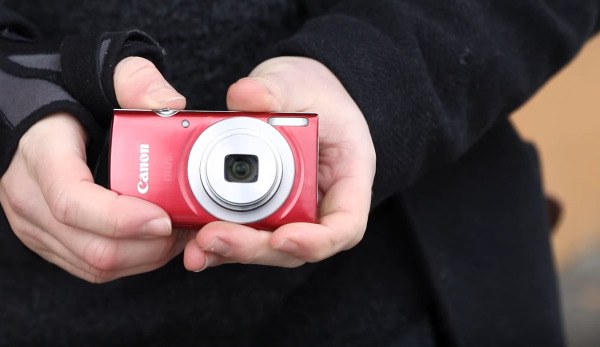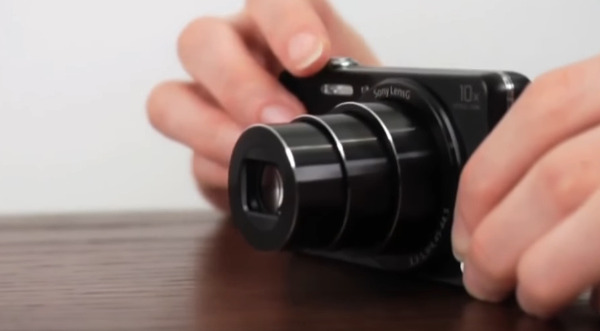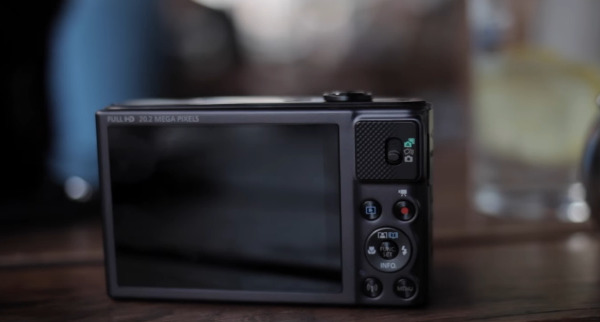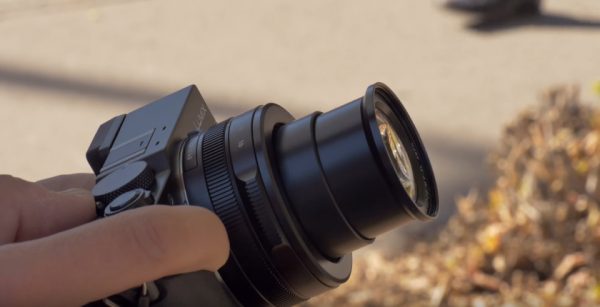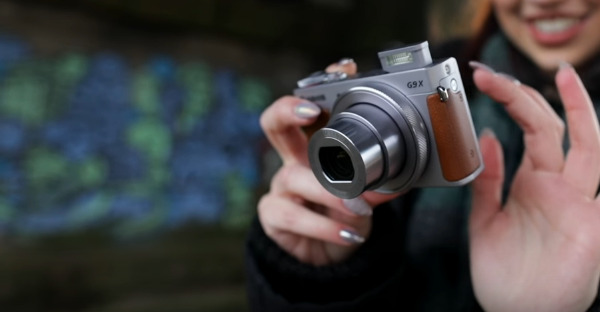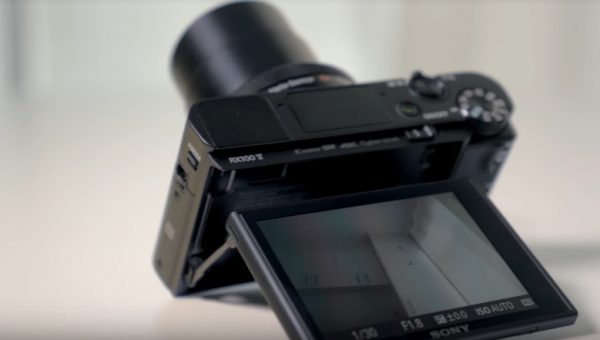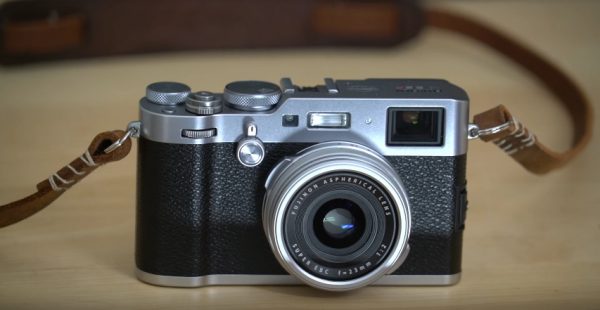After evaluating the most modern devices, I concluded that the Canon G9 X MK II was the best compact camera of 2017! To learn more about it, check out the second part of this comparison dealing with mid-range models.
Don’t forget to read the buyer’s guide at the end of this comparison for more information!
The best compact cameras retailing for under 200$
The entry-level segment of the compact camera market has been struggling lately. These days, smartphones are poised to overtake compact cameras since, on the whole, they retail for less and often have better image quality.
For a camera to be competitive in this segment of the market, it needs, at the very least, to be as practical as a smartphone. It must have good connectivity and an accompanying app that makes it easy to share photos. And, what about image quality? This is usually not something that entry-level cameras excel at, especially compact cameras…
That having been said, I tried hard to find the three compact cameras that had good enough quality to supersede most smartphones.
Canon PowerShot ELPH 190: the compact camera tailored to capturing memories
- Ultra-compact
- NFC chip
- WiFi connectivity
- Decent image quality
The Canon PowerShot ELPH 190 was released in 2017. Much effort was put into to making this camera as thin as possible; as such, it is Canon’s most compact camera. But what did Canon have to sacrifice in order to achieve this degree of compactness? Because it is lightweight and easy to hold, the ELPH 190 should be able please a wide audience; however, anyone expecting very good image quality from this compact camera is likely to be disappointed – in spite of its 20-megapixel sensor…
What makes the Canon ELPH worthy of appearing in this comparison is its extensive range of features usually reserved for more expensive devices – such as its NFC and WiFi connectivity. As a result, the ELPH is one of the least expensive compact cameras, but, paradoxically, also one of the most flexible in terms of transferring files.
This camera’s controls are pretty straightforward: an on/off button, a shutter release button, and a navigation menu next to its LED display; people familiar with Canon products should be able to find their way around the ELPH quite easily. This camera’s zoom button felt a little small to me, but its small size contributes to the ELPH 190’s minimalist appearance.
As is the case with many ELPH cameras, the 190’s LED display is not great. To get a good idea of how a photo turned out, you will need to export it to a computer – thankfully, the 190 makes the transfer process very easy.
Since this camera is mainly geared towards novice users, it has rather limited shooting options – especially when it comes to shooting video. The 190’s focus, for example, is entirely automatic. As far as photography is concerned, only the bare minimum options are available; that is to say an ISO and exposure adjustment as well as a crude contrast and color balance adjustment.
At any rate, it is not in terms of image quality that the ELPH 190 excels. Even at a low ISO setting, a little bit of film grain can be seen. Past ISO 400, which is a relatively low setting, the film grain becomes very noticeable.
On a more positive note, this camera has decent color and white balances. Its colors are vibrant, properly saturated and precise enough for small-format photos.
If I were to recommend the ELPH 190 to any one specific category of user, it would be to non-artist photographers. The ELPH 190 is great for taking photos on vacation or at a birthday party for example and the ELPH makes it exceptionally easy to transfer your files to another device.
Sony Cybershot WX220: a good balance between enjoyment and image quality
- WiFi and NFC connectivity
- Nice predefined filters
- Very decent image quality
- The menu is a little too cluttered
Sony’s WX220 is a rather conventional and simple camera. However, despite its low price, it still has a lot to offer. A 10x zoom, 18.2 Mpx sensor, WiFi and NFC connectivity are some of the characteristics that enable compact cameras, like the WX220, to compete against high-end smartphones.
The WX220 is among Sony’s most compact cameras: it pretty much fits in the palm of your hand! As with the ELPH, there are very few controls on the camera itself, but I find that its ergonomics are much better designed than those of the ELPH.
For example, the camera’s various options can be controlled via the small wheel surrounding the “OK” button. This makes it much easier to navigate through the camera’s menus – something which can be very difficult to do on compact cameras.
The inclusion of NFC and WiFi connectivity on this camera is a real advantage. This connectivity can be accessed via an intuitive procedure; you could, for example, couple the WX220 with a smartphone in order to automatically transfer photos and videos to it. Sony’s application – PlayMemories – makes it possible to quickly compile and share albums. The most recent Android and iOS app upgrades have also made it possible to control the WX220 remotely. As you can imagine, this feature is especially useful for taking group photos!
The WX220’s image quality is significantly better than that of the ELPH. Its colors are rich without being oversaturated. In panorama mode, the colors seem a little washed out, but at least this camera has a panorama mode which is more than can be said for other products.
A myriad of instant filters can be accessed via Sony’s OS. While this type of filter may seem pretty standard, I find the WX220’s filters to be particularly well calibrated.
Let’s summarize: the Sony WX220 is a little more expensive than the ELPH 190, but it has more features and doesn’t compromise (as much) on image quality. All things considered, Sony’s WX220 has one of the best quality to price ratios of all the cameras appearing in this comparison!
Canon Powershot 620HS: Canon is not willing to back down from smartphones!
- 25x optical zoom (50x digital zoom)
- Good image quality
- NFC and WiFi connectivity
- Laborious navigation procedure
With a 25x zoom, 20.2 Mpx sensor, and a faster shutter speed than its competitors, the Canon Powershot 620 HS is a powerhouse in the entry-level category. In addition to its good image properties, it is also equipped with vital NFC and WiFi connectivity.
More compact and lightweight than its Powershot predecessors, this 2017 model has a well-conceived design. On its rear side can be found a 3″ LCD display of superior quality and resolution to the display used in the ELPH line of products.
It couldn’t be easier to use this camera’s basic modes. The utility of the three buttons on the rear face of the camera is not immediately apparent; as it turns out, they can be used to switch between the camera’s various modes. The most generic of these modes is “Smart Auto”, in which all aspects of the camera’s operation are controlled automatically by the camera.
It is also possible to manually control the most important setting via the main menu: ISO, mode, white balance… The camera’s various predefined filters can also be accessed via this menu. Contrary to Sony’s Cybershot, the Powershot only has 6 filters.
This camera’s WiFi and NFC connectivity allow it to access a number of photo sharing and modification options. For example, it is possible to add a geolocation tag to a photo by accessing GPS data from a smartphone.
And what about this camera’s image quality? As you might suspect, given the Powershot 620HS’s price, its image quality is not exceptional. Nevertheless, it does perform better than either the ELPH or the Cybershot. Its ISO sensitivity ranges from ISO 80 to 3200, and it does a fairly good job at preserving image quality at higher ISO values.
I began by mentioning that this camera is equipped with a 25x zoom; an additional digital zoom enables it to achieve 50x magnification with relatively little loss of image quality.
On the whole, the Powershot 620HS does not distinguish itself by its image quality, but its many features – such as its filters and settings – make it a good overall compact camera. Furthermore, the power of its zoom gives it a considerable advantage over smartphones.
While this camera’s image quality is not the best, its versatility makes it a good choice.
The best compact cameras retailing for between 200 and 500$
Compact cameras retailing for more than 200€, are usually constructed out of metal, rather than plastic, which gives them a more solid appearance. It is also beyond the 200€ threshold that compact cameras start to become more specialized: better camera, better zoom, 4K video, 1″ sensor, etc…
Of course, this specialization often has a detrimental impact on a camera’s “compactness”, but a 30-gram increase in a camera’s weight is not the end of the world either. I have uncovered two powerhouses in this mid-range category: one is the newest member of Panasonic’s excellent Lumix product line, the other is manufactured by Canon.
It goes without saying that cameras in this price range are expected to have better image quality than less expensive models, as well as having an intuitive navigation.
Panasonic Lumix ZS100: small body, large zoom!
- 4K video recording
- 10x zoom with no loss of quality
- Decent image quality
- Touchscreen
- No NFC connectivity
- No microphone input for video recording
Panasonic’s Lumix product line seems to be the best placed to compete in this ultra-competitive market. The ZS100 lies somewhere in between a compact and a hybrid camera and has very interesting features. For example, this camera is able to record 4K video. Not bad! Compact, serious and with good endurance, the Lumix ZS100 is also one of the best cameras for travelers.
However, since it is equipped with a somewhat bulky 10x zoom, it is less compact than competing products from Sony and Canon. It can be carried around in a bag without taking up much room, but you can’t just slip it into your jeans pocket.
The ZS100’s design is impeccable. Most of its components and buttons are metal – which makes them solid and comfortable to use. This camera has efficient and comprehensive manual controls. It is also nice that a number of its functions can be accessed via physical buttons rather than having to navigate through interminable menus. The ZS100 is equipped with Panasonic’s signature wheel which allows for switching between the camera’s 10 predefined modes. I really like the fact that the ZS100 is equipped with an EVF (the viewfinder allows you to frame a shot without using the display – a real battery saver). The inclusion of a viewfinder also gives this camera a more “organic” feel which more closely resembles that of a traditional camera!
The ZS100’s 3″ display has over 1 million pixels: almost 5 times more than the Sony Cybershot’s display. What’s more, the ZS100’s display is also tactile and allows for very intuitive focus selection; just like on a smartphone, all you need to do is select a zone to focus on!
Thanks to its WiFi connectivity, the ZS100 has no need for an internal GPS system; you can add a geolocation tag to your photos via the camera’s application. However, the ZS100 is not equipped with NFC connectivity, which is a shame. On the other hand, this camera’s battery autonomy is a little better than that of its competitors – 300 photos, versus 220 for entry-level products.
One of this camera’s main assets is its lens. While the ZS100’s lens makes it less compact than competing models, it is totally worth the sacrifice. As a result, the characteristic which most sets the ZS100 apart from the competition is its image quality.
This camera is equipped with a 1″ sensor: a remarkable achievement for this type of device. Nevertheless, this camera is still subject to the same problems that afflict most compact cameras. Beyond ISO 1600, film grain starts to become apparent. Below this ISO value, colors are vibrant and images have decent sharpness. Its 20 Mpx sensor provides acceptable results even when using maximum zoom: letters remain visible at a distance of 200 meters. Its zoom is one of this camera’s major strengths; image quality remains exceptional even at maximum magnification.
What’s more, this camera is able to record video in 4K definition (at 25 fps, which isn’t too bad) – more than can be said for other devices! At 1080p definition, it is able to record video with a frame rate of between 50-60 fps. Unfortunately, it is not possible to connect an external microphone to this camera; as a result, you will be forced to rely on its built-in microphone which is not the best…what a shame!
To conclude, having an efficient zoom on such a small camera is a real advantage. Its good build-quality, metal construction, and wide-ranging options make this camera competitive with other similar products and a real pleasure to use!
Canon G9 X MKII: The compact camera with the best quality to price ratio!
- WiFi, NFC, and Bluetooth connectivity
- Ultra-compact
- Nice retro design
- Good image quality
- 3” touchscreen
- Grain correction is somewhat visible at ISO >3200
- Only FHD video
Luxury compact cameras with 1″ sensors have created a niche market for themselves. These 1″ sensors, like the one on the ZS100, are able to provide much better image quality than competing devices. As a result, these cameras are able to attract a much wider audience.
However, the inclusion of this type of sensor is often done at the cost of compactness; would you prefer to have a more “serious” camera with many settings or one that you can easily slip into your pocket? This was the dilemma confronting the G9 X. The Mark II is a sort of updated version of the previous model (which did not offer the same degree of flexibility). So, how good is this new Canon compact camera?
The G9 X Mark II has a 1″ 20.1 Mpx sensor and features the brand new DIGIC 7 processor which has been producing miraculous results for Canon compact cameras since mid-2017. However, the Mark II’s zoom is not as impressive as that of the Lumix. Nevertheless, since it only has a 3x times zoom, it has the virtue of being more compact.
It is also worth mentioning that this camera is equipped with NFC, WiFi, and Bluetooth connectivity. Despite its retro hipster look, it is technically very well endowed! Its entirely metal construction is also a very nice feature. On the camera’s rear side are located four buttons as well as a 3″ sRVB (16.5 million colors) touchscreen. It is always nice to see this kind of minimalist design on such a small device! The first button can be used to initiate video recording (FHD definition only). The second can be used to display certain data on the screen. The third button opens a relatively comprehensive menu in which easy-to-use settings can be found. Thanks to its touchscreen, this camera’s various options can be navigated with great ease.
However, it is in terms of image quality that the G9 X Mark II most significantly sets itself apart from the competition. Much of the image optimization is performed automatically, making it much more comfortable for amateur users. And the results are quite impressive: vibrant colors, sharp image… Canon’s new processor works wonders even though it does so by approximating at times. For example, in order to resolve the problem of film grain which affects many compact cameras at moderately high ISO values, the Mark II’s processor compensates by softening photos. As a result, at ISO values in excess of 3200, the resulting images may appear glossy and somewhat unnatural – but this effect is barely noticeable.
It is therefore perfectly suited for everyday photography. It is one of the best cameras in the compact category; it succeeds at the difficult task of combining many options, good image quality, and remarkable compactness. If you are looking for a compact camera that can outperform your smartphone (for a number of years to come), Canon’s G9 X Mark II would be an excellent choice.
The best high-end compact cameras
The high-end segment of the compact camera market is going through a strange phase at the moment. Out of all the different categories of compact cameras, high-end models have been the most successful at competing against the increasing popularity of smartphones, despite their high cost; manufacturers are investing a lot of effort in developing technologies specific to this category of devices.
A few real gems can be found in this segment of the compact camera market. The 2017-2018 period bore witness to many innovations; I have chosen to speak about two of the best cameras which first made their entry into the market during this period. What makes these two devices so special? While these two cameras can be considered to belong to the compact category, they are entirely capable of rivaling some of the hybrid and reflex cameras being sold for the same price… Can these two devices even be considered better all-around cameras? Perhaps…
Sony RX100V: the most complete 2018 Powershot
- 4K video
- Very decent image quality
- Tiltable display
- No touchscreen
- A little expensive
We spoke about the W220 earlier; it is now time to discuss Sony’s high-end model: the RX100V, released during the autumn of 2017. In the face of competition from smartphones, it has become essential for manufacturers to adapt to an increasingly competitive market. This is something that Sony did by paving the way with its RX100 – which was later imitated by Canon and Panasonic.
The RX100V brings several innovations to the table. It shares some of the same characteristics as other cameras we spoke about earlier: a 1″ 20 Mpx sensor, and a video recording definition of up to 4K. Thanks to its large sensor as well as to a technical prowess on Sony’s part which consists of positioning the memory chip directly behind the sensor, the RX100V is able to achieve a much faster recording speed than its competitors. In burst mode, the RX100V is capable of taking up to 24 photos per second; video recording is also very fluid, even at high resolution.
Unfortunately, its 3″ display, which is located at the rear of the camera, is not tactile. This a something of a disappointment for a camera in this price range. On the other hand, the RX100V’s display does have an exceptionally high resolution as well as very good color fidelity.
The RX100V’s design is relatively conventional, but at the same time ingenious. It’s EVF, a feature which is usually only found on hybrid or reflex cameras is well-situated and does not negatively impact the camera’s compactness in any way. In fact, it is even retractable, like the flash on certain models of compact camera.
We should take a moment to speak about this camera’s image quality: there are many good things which can be said about it. Just like with Canon’s G9 X, the RX100V’s automatic white balance is well calibrated. As I mentioned before, it is possible to determine a compact camera’s quality by establishing at what ISO value images begin to lose their sharpness. In this particular case, it is at ISO 6400 that film grain first becomes apparent – a rather impressive achievement for a compact camera.
The RX100V’s large sensor allows for what is called Dynamic Range which consists of making a subject stand out from its background by means of a slight blurring effect. This makes photos look more natural and gives them more character.
It is at this point in our comparison that we will be discussing compact cameras which retail for about the same price as hybrid cameras. There are very few compact cameras good enough to compete with hybrids – which are usually larger, more expensive and oftentimes more complete. However, Sony’s RX100V is among the few devices that truly validate the existence of high-end compact cameras.
Fujifilm X100S: A retro gem with many modern innovations
- Very nice retro look
- New generation of 1” sensor
- NFC and WiFi connectivity
- Less compact than competing models
- Expensive
There are many things that could be said about this highly original compact camera. Its retro look and technical prowess explain in part why photography enthusiasts are so excited about it.
The performance of this camera’s sensors (already praised by professional photographers since the X100 version) has been further improved. Thanks to an innovative technological development, the sensor no longer requires color filters. The result is sharper, better balanced, and nicer looking photos.
Whether it is in terms of its autofocus or its image quality, the X100s is able to rival hybrid cameras, despite only being half the size!
Its ergonomics are in sync with its retro look; this camera takes a more mechanical approach to photography. Most of this camera’s functions are controlled via physical buttons and the X100s encourages its users to make use of its EVF when framing shots. All of these features contribute to the retro 70’s look of the X100s and provide a more organic photography experience than most other digital cameras – especially compact cameras!
Most of this camera’s parts are constructed out of metal which makes it feel solid and dense.
Despite this camera’s retro look, there is nothing outdated about it. Its autofocus is surprisingly fast, so much so that it rivals certain hybrid cameras such as the Olympus OM-D. It also has remarkably efficient and stealthy firmware.
The X100s is equipped with WiFi and NFC connectivity; it is basically cutting-edge technology in a retro body – like a Tesla engine in a Cadillac car.
Fujifilm’s X100s has become an instant classic. While it does retail for a very high price, its versatility allows it to supplant a good portion of the cameras currently available on the market – while being much smaller than a reflex camera. There is a compact camera revolution underway and small devices (weighing barely 250 grams) are beginning to offer results that were previously only achievable with 2 kg of photographic equipment!
How to choose a compact camera – buyer’s guide
The world of photography can often appear very complicated to novice users. I have no intention of turning Chromebookeur into yet another specialized photography site where highly technical details are discussed.
Let’s simply start off by defining what a compact camera is – since this definition is constantly evolving. With more and more ultra-powerful smartphones (in terms of photography) entering the market, cameras have had to adapt. The very many cameras retailing for under 120€ which saturated the market in the early 2000s have all gone the way of the dodo: any Samsung (or even Motorola) phone has about the same level of performance these days.
The idea is not to let yourself be tricked into buying one of the many obsolete cameras still available on the market. Therefore, you should ask yourself a few key questions before making any purchase.
What are the advantages of a compact camera?
There is a clue in the name: the main advantage of these cameras is their portability. Compact cameras range from very small devices – like Sony’s entry-level Powershot product line – which can easily be slipping into a pocket, to larger devices – such as some of the models manufactured by Fujifilm. Generally speaking, compact cameras weigh less than 400 grams and have a lens which (ideally) occupies a large portion of the front side of the device.
The main issue with this type of camera is quality. In order to achieve such a high degree of compactness, most models have a quality much inferior to that of a hybrid or reflex camera.
Therefore, ask yourself what is more important to you: to have a camera that you can easily bring with you anywhere you go or to have a camera which provides excellent image quality? If portability is your most important consideration, you should be aware of the advantages that a compact camera has over a smartphone. This brings us to our second question.
What are a compact camera’s defining characteristics?
You may be surprised to learn that a compact camera’s megapixel count is not its most important characteristic. On the contrary, Fujifilm’s X100s, for example, only has a 16 Mpx sensor– despite retailing for almost 1000€! – whereas a small Canon device retailing for 150€ might boast about having a 20 Mpx sensor. When a manufacturer crams too many megapixels into such a small camera, it can result in excessive film grain due to the vast amount of information being captured across such a small surface area.
The really important criterion is the sensor itself. A digital sensor is analogous to film; when you are taking a photo, the sensor is exposed to light and its various components record the information they receive. There are as many different types of sensors as there are brands and product lines; I will spare you from having to read through an exhaustive list. On the other hand, the sensor’s size is of great importance. The larger it is, the more surface area it will have for capturing information. That’s easy enough to understand, right? Now you can understand the main limitation of compact cameras: their small size necessarily results in a smaller sensor.
You may have noticed that all throughout my comparison, I have attempted to only mention compact cameras that have at least a 1″ sensor. If you purchase a compact camera with a large sensor from a reputable manufacturer for occasional use (holiday photos, souvenir photos…), you can’t go wrong.
What are a compact camera’s main features?
Manufacturers love to overload consumers with a lot of brand-specific terminology which often doesn’t say much. A compact camera’s main features are in fact quite easy to comprehend. Above all, compact cameras are expected to be easy to use.
That is why I am such a fan of Panasonic’s compact cameras; the small wheel on the top of these cameras does not take up much room and makes it easy to navigate through their various options. Another alternative would be a camera with a touchscreen measuring at least 3″ with good visibility.
Many people consider the inclusion of an EVF on compact cameras to be a hipster fad. An EVF allows you to frame a shot by looking at a small mirror (like with a traditional camera, you close one eye and shoot the photo!). However, these viewfinders can be useful; not all LCD displays are bright enough to be seen in full sunlight. What’s more, using a viewfinder saves battery power.
There is also the question of WiFi, Bluetooth, and NFC connectivity. Most cameras are now equipped with NFC connectivity; an NFC chip makes it fast and easy to share your photos. That having been said, NFC connectivity is not vital; transferring files via WiFi or Bluetooth may take a few seconds longer, but who doesn’t have a few extra seconds to spare? I know that I have listed the lack of NFC connectivity as a “Con” for many of the devices in this comparison, but don’t cross a camera off your Christmas list for this reason alone; depending on your particular needs, the lack of NFC connectivity may not be of serious concern to you anyway.
